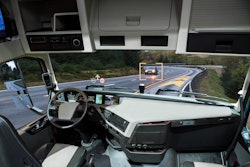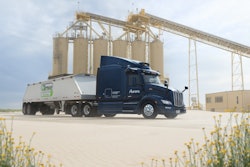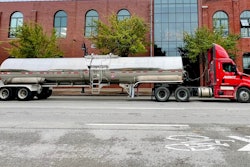During his 34 years as an over-the-road trucker, Alan Kitzhaber said he witnessed many instances of fellow professional drivers doing “really stupid things:” speeding, making dangerous passes, following too close and more.
“One time going across the Mackinac Bridge, … there was a truck driver passing at the top of the bridge, and there are signs all along there that say, ‘Trucks do not pass. Trucks maintain 500-foot following distance. Truck speed limit 20 miles an hour,’ and he violated every single one of those,” Kitzhaber said. “I can't tell you how many times I’ve had truck drivers that just come racing up the left side of me … only to get right up and tailgate the truck or four-wheeler that's in front of them in that left lane trying to intimidate them to move out of their way.”
Kitzhaber took matters into his own hands back before dash cameras were available for purchase and mounted a hand-held recorder to his dashboard using a 2-by-4 piece of wood. He would call those drivers’ companies and report them with the video footage to back it up.
The owner operator said he noticed a notable decrease in the frequency of those calls before leaving his life on the road for retirement in April. He attributed that to an increase in the adoption of dash cameras.
“I don't see as much bad driving out there as I used to years ago I think just simply because there are too many cameras out there,” Kitzhaber said. “Now the truck drivers know that they can't get away with pulling that crap. The ones that do – the most aggressive drivers out there – are not company drivers anymore. The (aggressive) ones are guys that have their own authority or are working for a small company that just kind of turns the other cheek and lets them do whatever as long as they get their freight there on time.”
Shifting strategy
Video as part of a safety system can be quite expensive.
That’s why Jonah Towler thinks there will always be a market for less sophisticated ways to get dash cam footage, like Kitzhaber’s rigged up Handycam or a cheap dash-mount camera with no subscription required. Those options serve a purpose for owner operators or small fleets that don’t need additional features like driver coaching and telematics data that can provide greater insight into driver behavior.
Towler, senior product consultant at Rand McNally, which offers both types of dash camera, said his company is seeing a shift.
“Our customers are shifting towards expecting more from dash cams,” he said. “It's really easy to get one from eBay or Amazon, so I think there will always be a place for those, but we find that those are generally more for consumers (owner operators) because they're very hard to administer when you've got over 500 trucks.”
Johan Land said it’s about proactive safety, whereas a basic dash cam is reactionary.
Land, senior vice president of product and engineering at Samsara, said an owner operator solely focused on exoneration might opt for a basic recording device. But the broader trucking industry is moving toward dash cameras with alert and coaching options.
“It's a fundamental shift driven by a focus on proactive safety. Fleets are realizing that preventing incidents before they happen, through real-time alerts for things like speeding, drowsiness, or forward collision warning offers a far greater return on investment than just having a recording for after the fact,” Land said. “It's about empowering drivers, building a stronger safety culture, and ultimately ensuring everyone gets home safe.”
Samsara customer UniGroup, a transportation cooperative that handles one-third of all professional moves in the United States, saw a 42% reduction in safety events in one year after their first dash cam deployment by using in-cab alerts to reinforce safe driving practices.
“This isn't just theory; it's proven impact,” Land said.
Motive is another option.
Agmark saw up to a 70% reduction in accidents in its first year deploying Motive solutions.
Motive’s AI dashcams and omnicams detect unsafe behaviors like drowsiness or distracted driving and provide instant in-cab alerts and automated post-trip feedback. This feedback loop helps drivers self-correct and can reduce incidents and improve insurance outcomes, said Motive Head of Safety and Compliance Strategy Gary Johnson.
“There’s no one-size-fits-all approach to dash cams, but across the industry, we’re seeing a clear shift toward intelligent, AI-powered solutions that go beyond exoneration to actively improve safety and performance,” Johnson said. “Fleets are investing in tools that deliver real-time alerts and personalized coaching because how a driver behaves behind the wheel impacts everything from safety to fuel efficiency.”
Recorded vs. coached
Nearly 50,000 people died in roadway crashes last year, and fleets are looking for tools that not only document incidents but help prevent them, Johnson said.
Because of that – and other reasons like insurance cost reduction and increases in operational efficiency – dash cam adoption has been on the rise.
Johnson and Land both said they expect to see dash cam use to rise as new, connected trucks hit the road.
Land said the telematics data from connected cabins – things like GPS, engine data, vehicle speed – can be combined with dash cam footage to provide a much richer, more comprehensive understanding of any driving event.
“This context is invaluable for coaching, accident reconstruction, and overall safety analysis,” he said.
But the dash cam coaches are the preventative element.
Land said Kitzhaber was ahead of his time, recognizing the power of video as evidence and a means to improve safety. But, he said, it’s not entirely because they’re being watched – at least not long term.
“In the initial phases, we do see safety events go down merely from that 'being watched' effect, but that behavior quickly bounces back up within a week or two,” Land said. “The main, sustainable impact comes from the active safety features and the subsequent coaching. Real-time alerts provide immediate feedback, allowing drivers to self-correct. Then, the subsequent coaching discussions, backed by objective video evidence – something we focus heavily on providing at Samsara – help reinforce safe habits and address the root causes of risky behavior.”
Johnson agreed, adding that visibility creates accountability, but the best results come when drivers feel supported, not surveilled.
The coaching element is critical for behavior change, he said, adding that Motive’s AI dashcams prevented nearly 10,000 accidents in 2024 by detecting risky behavior like seat belt violations or cell phone use in real time and alerting the driver immediately.
Johnson said that kind of instant feedback is near impossible to scale manually, and it’s one of the toughest challenges fleets face. Kitzhaber’s process was a manual one, but today’s solutions like Motive, Samsara, Lytx, Isaac Instruments and others automate the process.
“Traditional sessions take time to plan and often happen weeks after the event, long after the unsafe behavior has happened. It’s also hard to ensure every manager is delivering feedback consistently,” Johnson said. “With advanced dash cams and fleet safety solutions, coaching becomes fast, consistent, and data driven. Managers can track driver safety scores generated from individual behaviors, identify top performers, and focus coaching efforts where needed most.
“Beyond safety, the benefits are also clear. Organizations see reduced costs, better compliance, improved morale, lower insurance premiums, and a positive impact on a company’s reputation,” he added. “Advanced dash cams turn safety from a reactive process into a strategic advantage, and that’s what’s driving adoption across the industry.”









